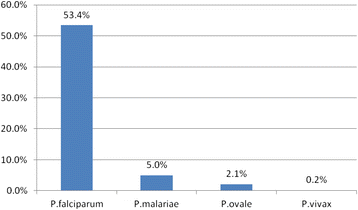Patterns of mixed Plasmodium species infections among children six years and under in selected malaria hyper-endemic communities of Zambia: population-based survey observations
- PMID: 25930101
- PMCID: PMC4424549
- DOI: 10.1186/s12879-015-0935-7
Patterns of mixed Plasmodium species infections among children six years and under in selected malaria hyper-endemic communities of Zambia: population-based survey observations
Abstract
Background: Although malaria is preventable and treatable, it still claims 660,000 lives every year globally with children under five years of age having the highest burden. In Zambia, malaria rapid diagnostic tests (RDTs) that only detect Plasmodium falciparum are the main confirmatory means for malaria diagnosis in most health facilities without microscopy services. As a consequence of this P. falciparum species diagnostic approach, non-falciparum malaria is not only under-diagnosed but entirely missed, thereby making the exact disease burden unknown. We thus investigated the prevalence of various Plasmodium spp. and associated burden of infection in selected communities in Zambia.
Methods: Data from two malaria hyper-endemic provinces (Eastern and Luapula) of the 2012 National Malaria Indicator Survey (MIS), conducted between April and May 2012, were used. The MIS is a nationally representative, two-stage cluster survey conducted to coincide with the end of the malaria transmission season. Social, behavioural and background information were collected from households as part of the survey. Thick blood smears, RDTs and dried blood spots (DBS) were collected from children below six years of age. Slides were stained using Giemsa and examined by microscopy while polymerase chain reaction (PCR) was used to analyse the DBS for malaria Plasmodium spp. Multivariate logistic regression was employed to examine the association between background factors and malaria.
Results: Overall, 873 children younger than six years of age were surveyed. The overall prevalence of Plasmodium spp. by PCR was 54.3% (95% CI 51-57.6%). Of the total Plasmodium isolates, 88% were P. falciparum, 10.6% were mixed infections and 1.4% were non-falciparum mono infections. Among the mixed infections, the majority were a combination of P. falciparum and P. malariae (6.5% of all mixed infections). Children two years and older (2-5 years) had three-fold higher risk of mixed malaria infections (aOR 2.8 CI 1.31-5.69) than children younger than two years of age.
Conclusion: The high prevalence of mixed Plasmodium spp. infections in this population stresses review of the current malaria RDT diagnostic approaches. The observed less incidence of mixed infections in children under two years of age compared to their older two-to-five-year-old counterparts is probably due to the protective maternal passive immunity, among other factors, in that age group.
Figures
Similar articles
-
Distribution of Plasmodium species and assessment of performance of diagnostic tools used during a malaria survey in Southern and Western Provinces of Zambia.Malar J. 2019 Apr 11;18(1):130. doi: 10.1186/s12936-019-2766-2. Malar J. 2019. PMID: 30971231 Free PMC article.
-
Performance evaluation of RDT, light microscopy, and PET-PCR for detecting Plasmodium falciparum malaria infections in the 2018 Zambia National Malaria Indicator Survey.Malar J. 2021 Sep 28;20(1):386. doi: 10.1186/s12936-021-03917-6. Malar J. 2021. PMID: 34583692 Free PMC article.
-
Probing the composition of Plasmodium species contained in malaria infections in the Eastern region of Ghana.BMC Public Health. 2019 Dec 2;19(1):1617. doi: 10.1186/s12889-019-7989-1. BMC Public Health. 2019. PMID: 31791319 Free PMC article.
-
Plasmodium spp. mixed infection leading to severe malaria: a systematic review and meta-analysis.Sci Rep. 2020 Jul 6;10(1):11068. doi: 10.1038/s41598-020-68082-3. Sci Rep. 2020. PMID: 32632180 Free PMC article.
-
Global trend of Plasmodium malariae and Plasmodium ovale spp. malaria infections in the last two decades (2000-2020): a systematic review and meta-analysis.Parasit Vectors. 2021 Jun 3;14(1):297. doi: 10.1186/s13071-021-04797-0. Parasit Vectors. 2021. PMID: 34082791 Free PMC article.
Cited by
-
Plasmodium malariae and Plasmodium ovale infections in the China-Myanmar border area.Malar J. 2016 Nov 15;15(1):557. doi: 10.1186/s12936-016-1605-y. Malar J. 2016. PMID: 27846879 Free PMC article.
-
Direct detection of falciparum and non-falciparum malaria DNA from a drop of blood with high sensitivity by the dried-LAMP system.Parasit Vectors. 2017 Jan 13;10(1):26. doi: 10.1186/s13071-016-1949-8. Parasit Vectors. 2017. PMID: 28086864 Free PMC article.
-
Under the Radar: Epidemiology of Plasmodium ovale in the Democratic Republic of the Congo.J Infect Dis. 2021 Mar 29;223(6):1005-1014. doi: 10.1093/infdis/jiaa478. J Infect Dis. 2021. PMID: 32766832 Free PMC article.
-
Non-random distribution of Plasmodium Species infections and associated clinical features in children in the lake Victoria region, Kenya, 2012-2018.Trop Med Health. 2024 Aug 5;52(1):52. doi: 10.1186/s41182-024-00622-3. Trop Med Health. 2024. PMID: 39103954 Free PMC article.
-
Prevalence, characteristics and risk factors of imported and local malaria cases in North-Western Province, Zambia: a cross-sectional study.Malar J. 2020 Nov 23;19(1):430. doi: 10.1186/s12936-020-03504-1. Malar J. 2020. PMID: 33228684 Free PMC article.
References
-
- WHO news release, 2011 http://www.who.int/malaria/world_malaria_report_2011/en/ (Accessed on 10 October 2013).
-
- World Health Organisation report, World Malaria Report 2012 http://www.who.int/malaria/publication/world_malaria_report_2012/report/en (Accessed on 12 October 2013).
Publication types
MeSH terms
Grants and funding
LinkOut - more resources
Full Text Sources
Other Literature Sources
Medical
Research Materials
Miscellaneous


